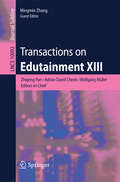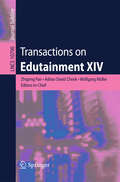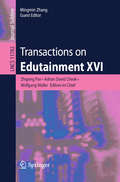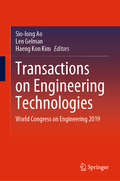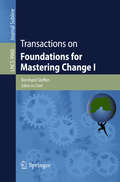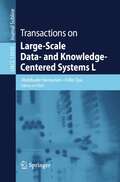- Table View
- List View
Transactions on Edutainment XIII
by Zhigeng Pan Adrian David Cheok Mingmin Zhang Wolfgang MüllerThis journal subline serves as a forum for stimulating and disseminating innovative research ideas, theories, emerging technologies, empirical investigations, state-of-the-art methods, and tools in all different genres of edutainment, such as game-based learning and serious games, interactive storytelling, virtual learning environments, VR-based education, and related fields. It covers aspects from educational and game theories, human-computer interaction, computer graphics, artificial intelligence, and systems design. The 25 papers presented in the 13th issue were organized in topical sections named: learning games and visualization; virtual reality and applications; 3D graphics technology, multimedia computing, and others.
Transactions on Edutainment XIV (Lecture Notes in Computer Science #10790)
by Zhigeng Pan Adrian David Cheok Wolfgang MüllerThis journal subline serves as a forum for stimulating and disseminating innovative research ideas, theories, emerging technologies, empirical investigations, state-of-the-art methods, and tools in all different genres of edutainment, such as game-based learning and serious games, interactive storytelling, virtual learning environments, VR-based education, and related fields. It covers aspects from educational and game theories, human-computer interaction, computer graphics, artificial intelligence, and systems design. The 19 papers presented in the 14th issue were organized in topical sections named: 3D modeling and visualization; image; e-learning and games; and miscellaneous.
Transactions on Edutainment XVI (Lecture Notes in Computer Science #11782)
by Zhigeng Pan Adrian David Cheok Mingmin Zhang Wolfgang MüllerThis journal subline serves as a forum for stimulating and disseminating innovative research ideas, theories, emerging technologies, empirical investigations, state-of-the-art methods, and tools in all different genres of edutainment, such as game-based learning and serious games, interactive storytelling, virtual learning environments, VR-based education, and related fields. It covers aspects from educational and game theories, human-computer interaction, computer graphics, artificial intelligence, and systems design. The 27 papers presented in this issue were organized in topical sections named: e-learning and on-line apps; image and graphics; VR/AR; CV and AI; and animation and miscellaneous.
Transactions on Engineering Technologies
by Sio-Iong Ao Oscar Castillo Gi-Chul Yang Xu HuangThis volume comprises selected extended papers written by prominent researchers participating in the International MultiConference of Engineers and Computer Scientists 2015, Hong Kong, 18-20 March 2015. The conference served as a platform for discussion of frontier topics in theoretical and applied engineering and computer science, and subjects covered include communications systems, control theory and automation, bioinformatics, artificial intelligence, data mining, engineering mathematics, scientific computing, engineering physics, electrical engineering, and industrial applications. The book describes the state-of-the-art in engineering technologies and computer science and its applications, and will serve as an excellent reference for industrial and academic researchers and graduate students working in these fields.
Transactions on Engineering Technologies: International MultiConference of Engineers and Computer Scientists 2018 (Lecture Notes in Electrical Engineering #275)
by Sio-Iong Ao Oscar Castillo Haeng Kon Kim Hideki Katagiri Alan Hoi-shou ChanThis book contains revised and extended research articles written by prominent researchers, selected from presentations at the International MultiConference of Engineers and Computer Scientists (IMECS 2018) held in Hong Kong, 14-16 March, 2018. Topics covered include engineering physics, communications systems, control theory, automation, engineering mathematics, scientific computing, electrical engineering, and industrial applications. The book gives a snapshot of selected advances in engineering technologies and their applications, and will serve as a useful reference for researchers and graduate students in these fields.
Transactions on Engineering Technologies: International MultiConference of Engineers and Computer Scientists 2021
by Sio-Iong Ao Oscar Castillo Mahyar A. Amouzegar Hideki Katagiri Alan ChanThis book contains a selection of revised and extended research articles written by prominent researchers participating in the international conference on Advances in Engineering Technologies and Physical Science, held in Hong Kong, October 20–22, 2021. This book demonstrates revised and extended research articles written by prominent researchers participating in the conference. Topics covered include engineering physics, communications systems, control theory, automation, engineering mathematics, scientific computing, electrical engineering, and industrial applications. The book offers the state of art of tremendous advances in engineering technologies and physical science and applications and also serves as an excellent reference work for researchers and graduate students working with/on engineering technologies and physical science and applications.
Transactions on Engineering Technologies: Proceedings of World Congress on Engineering 2021 (Lecture Notes in Electrical Engineering #919)
by Sio-Iong Ao Len GelmanThis book contains a selection of revised and extended research articles written by prominent researchers participating in the international conference on Advances in Engineering Technologies and Physical Science is held in London, UK, during July 7–9, 2021. This book demonstrates revised and extended research articles written by prominent researchers participating in the conference. Topics covered include mechanical engineering, bioengineering, Internet engineering, image engineering, wireless networks, knowledge engineering, manufacturing engineering, and industrial applications. The book offers the state of the art of tremendous advances in engineering technologies and physical science and applications and also serves as an excellent reference work for researchers and graduate students working with/on engineering technologies and physical science and applications.
Transactions on Engineering Technologies: Special Volume Of The World Congress On Engineering 2013 (Lecture Notes In Electrical Engineering #275)
by Sio-Iong Ao Len Gelman Haeng Kon KimThis volume contains a selection of revised and extended research articles written by prominent researchers participating in a large international conference on Advances in Engineering Technologies and Physical Science which was held in London, UK, 5-7 July, 2017. Topics covered include mechanical engineering, engineering mathematics, computer science, knowledge engineering, electrical engineering, wireless networks, and industrial applications. With contributions carefully chosen to represent the most cutting-edge research presented during the conference, the book offers the state of art in engineering technologies and physical science and applications, and also serves as an excellent reference work for researchers and graduate students working with/on engineering technologies and physical science and applications.
Transactions on Engineering Technologies: World Congress on Engineering 2018 (Lecture Notes In Electrical Engineering Ser. #275)
by Sio-Iong Ao Len Gelman Haeng Kon KimThis volume contains a selection of revised and extended research articles written by prominent researchers participating in The 26th World Congress on Engineering (WCE 2018) which was held in London, U.K., July 4-6, 2018. Topics covered include engineering mathematics, electrical engineering, communications systems, computer science, chemical engineering, systems engineering, manufacturing engineering, and industrial applications. With contributions carefully chosen to represent the most cutting-edge research presented during the conference, the book contains some of the state-of-the-art in engineering technologies and the physical sciences and their applications, and serves as a useful reference for researchers and graduate students working in these fields.
Transactions on Engineering Technologies: World Congress on Engineering 2019 (Lecture Notes In Electrical Engineering Ser. #275)
by Sio-Iong Ao Len Gelman Haeng Kon KimThis book contains a selection of research articles written by prominent researchers participating in The 27th World Congress on Engineering (WCE 2019) which was held in London, UK, July 3–5, 2019. Topics covered include engineering mathematics, electrical engineering, communications systems, computer science, chemical engineering, systems engineering, manufacturing engineering, and industrial applications. With contributions carefully chosen to represent the most cutting-edge research presented during the conference, the book contains some of the state of the art in engineering technologies and the physical sciences and their applications and serves as a useful reference for researchers and graduate students working in these fields.
Transactions on Engineering Technologies: World Congress on Engineering and Computer Science 2014
by Sio-Iong Ao Haeng Kon Kim Mahyar A. AmouzegarThis volume contains thirty-nine revised and extended research articles, written by prominent researchers participating in the World Congress on Engineering and Computer Science 2014, held in San Francisco, October 22-24 2014. Topics covered include engineering mathematics, electrical engineering, circuit design, communications systems, computer science, chemical engineering, systems engineering and applications of engineering science in industry. This book describes some significant advances in engineering technologies and also serves as an excellent source of reference for researchers and graduate students.
Transactions on Engineering Technologies: World Congress on Engineering and Computer Science 2017 (Lecture Notes In Electrical Engineering #275)
by Sio-Iong Ao Haeng Kon Kim Mahyar A. AmouzegarThis volume contains a selection of revised and extended research articles written by prominent researchers participating in a large international conference on Advances in Engineering Technologies and Physical Science which was held in San Francisco, California, USA, October 25-27, 2017. Topics covered include engineering mathematics, electrical engineering, communications systems, computer science, chemical engineering, systems engineering, manufacturing engineering, and industrial applications. With contributions carefully chosen to represent the most cutting-edge research presented during the conference, the book contains some of the state-of-the-art in engineering technologies and the physical sciences and their applications, and serves as a useful reference for researchers and graduate students working in these fields.
Transactions on Engineering Technologies: World Congress on Engineering and Computer Science 2018 (Lecture Notes In Electrical Engineering Ser. #275)
by Sio-Iong Ao Haeng Kon Kim Mahyar A. AmouzegarThis book features a selection of revised and extended research articles written by prominent researchers who participated in the 26th World Congress on Engineering and Computer Science (WCECS 2018), held in San Francisco, USA, on October 23–25, 2018. Topics covered include engineering mathematics, electrical engineering, communications systems, computer science, chemical engineering, systems engineering, manufacturing engineering and industrial applications. With contributions carefully chosen to represent the most cutting-edge research presented at the conference and highlighting the state of the art in engineering technologies and the physical sciences and their applications, the book is a valuable reference resource for graduate students and researchers working in these fields.
Transactions on Engineering Technologies: World Congress on Engineering and Computer Science 2019 (Lecture Notes In Electrical Engineering Ser. #275)
by Sio-Iong Ao Mahyar A. Amouzegar Haeng-Kon KimThis book contains a selection of revised and extended research articles written by prominent researchers participating in the 27th World Congress on Engineering and Computer Science (WCECS 2019) which was held in San Francisco, USA, on October 22–24, 2019. Topics covered include engineering mathematics, electrical engineering, communications systems, computer science, chemical engineering, systems engineering, manufacturing engineering, and industrial applications. With contributions carefully chosen to represent the most cutting-edge research presented during the conference, the book contains some of the state-of-the-art in engineering technologies and the physical sciences and their applications and serves as a useful reference for researchers and graduate students working in these fields.
Transactions on Foundations for Mastering Change I
by Bernhard SteffenThe LNCS Transactions on Foundations for Mastering Change, FoMaC, aims to establish a forum for formal-methods-based research, dealing with the nature of today's agile system development, which is characterized by unclear premises, unforeseen change, and the need for fast reaction, in a context of hard-to-control frame conditions, such as third-party components, network problems, and attacks. Submissions are evaluated according to these goals. This book, the first volume in the series, contains contributions by the members of the editorial board. These contributions indicate the envisioned style and range of papers of topics covered by the transactions series. They cross-cut various traditional research directions and are characterized by a clear focus on change.
Transactions on High-Performance Embedded Architectures and Compilers V (Lecture Notes in Computer Science #11225)
by Cristina Silvano Per Stenström Michael Schulte Koen BertelsTransactions on HiPEAC aims at the timely dissemination of research contributions in computer architecture and compilation methods for high-performance embedded computer systems. Recognizing the convergence of embedded and general-purpose computer systems, this journal publishes original research on systems targeted at specific computing tasks as well as systems with broad application bases. The scope of the journal therefore covers all aspects of computer architecture, code generation and compiler optimization methods of interest to researchers and practitioners designing future embedded systems.This 5th issue contains extended versions of papers by the best paper award candidates of IC-SAMOS 2009 and the SAMOS 2009 Workshop, colocated events of the 9th International Symposium on Systems, Architectures, Modeling and Simulation, SAMOS 2009, held in Samos, Greece, in 2009. The 7 papers included in this volume were carefully reviewed and selected. The papers cover research on embedded processor hardware/software design and integration and present challenging research trends.
Transactions on Intelligent Welding Manufacturing: Volume II No. 1 2018 (Transactions on Intelligent Welding Manufacturing)
by Shanben Chen Yuming Zhang Zhili FengThe primary aim of this volume is to provide researchers and engineers from both academia and industry with up-to-date coverage of recent advances in the fields of robotic welding, intelligent systems and automation. It gathers selected papers from the 2018 International Conference on Robotic Welding, Intelligence and Automation (RWIA 2018), held Oct 20-22, 2018 in Guangzhou, China. The contributions reveal how intelligentized welding manufacturing (IWM) is becoming an inescapable trend, just as intelligentized robotic welding is becoming a key technology. The volume is divided into four main parts: Intelligent Techniques for Robotic Welding, Sensing in Arc Welding Processing, Modeling and Intelligent Control of Welding Processing, and Intelligent Control and its Applications in Engineering.
Transactions on Intelligent Welding Manufacturing: Volume II No. 3 2018 (Transactions on Intelligent Welding Manufacturing)
by Shanben Chen Yuming Zhang Zhili FengThe primary aim of this volume is to provide researchers and engineers from both academia and industry with up-to-date coverage of recent advances in the fields of robotic welding, intelligent systems and automation. It gathers selected papers from the 2018 International Conference on Robotic Welding, Intelligence and Automation (RWIA 2018), held Oct 20-22, 2018 in Guangzhou, China. The contributions reveal how intelligentized welding manufacturing (IWM) is becoming an inescapable trend, just as intelligentized robotic welding is becoming a key technology. The volume is divided into four main parts: Intelligent Techniques for Robotic Welding, Sensing in Arc Welding Processing, Modeling and Intelligent Control of Welding Processing, and Intelligent Control and its Applications in Engineering.
Transactions on Intelligent Welding Manufacturing: Volume II No. 4 2018 (Transactions on Intelligent Welding Manufacturing)
by Shanben Chen Yuming Zhang Zhili FengThe primary aim of this volume is to provide researchers and engineers from both academia and industry with up-to-date coverage of recent advances in the fields of robotic welding, intelligent systems and automation. It gathers selected papers from the 2018 International Conference on Robotic Welding, Intelligence and Automation (RWIA 2018), held Oct 20-22, 2018 in Guangzhou, China. The contributions reveal how intelligentized welding manufacturing (IWM) is becoming an inescapable trend, just as intelligentized robotic welding is becoming a key technology. The volume is divided into four main parts: Intelligent Techniques for Robotic Welding, Sensing in Arc Welding Processing, Modeling and Intelligent Control of Welding Processing, and Intelligent Control and its Applications in Engineering.
Transactions on Intelligent Welding Manufacturing: Volume IV No. 1 2020 (Transactions on Intelligent Welding Manufacturing)
by Shanben Chen Yuming Zhang Zhili FengThe primary aim of this volume is to provide researchers and engineers from both academic and industry with up-to-date coverage of new results in the field of robotic welding, intelligent systems and automation. The book is mainly based on papers selected from the 2020 International Conference on Robotic Welding, Intelligence and Automation (RWIA’2020) in Shanghai and Lanzhou, China. The articles show that the intelligentized welding manufacturing (IWM) is becoming an inevitable trend with the intelligentized robotic welding as the key technology. The volume is divided into four logical parts: Intelligent Techniques for Robotic Welding, Sensing of Arc Welding Processing, Modeling and Intelligent Control of Welding Processing, as well as Intelligent Control and its Applications in Engineering.
Transactions on Intelligent Welding Manufacturing: Volume IV No. 2 2020 (Transactions on Intelligent Welding Manufacturing)
by Shanben Chen Yuming Zhang Zhili FengThe primary aim of this volume is to provide researchers and engineers from both academic and industry with up-to-date coverage of new results in the field of robotic welding, intelligent systems and automation. The book is mainly based on papers selected from the 2020 International Conference on Robotic Welding, Intelligence and Automation (RWIA’2020) in Shanghai and Lanzhou, China. The articles show that the intelligentized welding manufacturing (IWM) is becoming an inevitable trend with the intelligentized robotic welding as the key technology. The volume is divided into four logical parts: Intelligent Techniques for Robotic Welding, Sensing of Arc Welding Processing, Modeling and Intelligent Control of Welding Processing, as well as Intelligent Control and its Applications in Engineering.
Transactions on Intelligent Welding Manufacturing: Volume V No. 1 2021 (Transactions on Intelligent Welding Manufacturing)
by Shanben Chen Yuming Zhang Zhili FengThe primary aim of this book is to provide researchers and engineers from both academic and industry with up-to-date coverage of new results in the field of robotic welding, intelligent systems and automation. The book is mainly based on papers selected from the 2022 International Conference on Robotic Welding, Intelligence and Automation (RWIA’2022) in Shanghai and Lanzhou, China. The articles show that the intelligentized welding manufacturing (IWM) is becoming an inevitable trend with the intelligentized robotic welding as the key technology. The volume is divided into four logical parts: Intelligent Techniques for Robotic Welding, Sensing of Arc Welding Processing, Modeling and Intelligent Control of Welding Processing, as well as Intelligent Control and its Applications in Engineering.
Transactions on Intelligent Welding Manufacturing: Volume V No. 2 2021 (Transactions on Intelligent Welding Manufacturing)
by Shanben Chen Yuming Zhang Zhili FengThe primary aim of this volume is to provide researchers and engineers from both academic and industry with up-to-date coverage of new results in the field of robotic welding, intelligent systems and automation. The book is mainly based on papers selected from the 2022 International Conference on Robotic Welding, Intelligence and Automation (RWIA’2022) in Shanghai and Lanzhou, China. The articles show that the intelligentized welding manufacturing (IWM) is becoming an inevitable trend with the intelligentized robotic welding as the key technology. The volume is divided into four logical parts: Intelligent Techniques for Robotic Welding, Sensing of Arc Welding Processing, Modeling and Intelligent Control of Welding Processing, as well as Intelligent Control and its Applications in Engineering.
Transactions on Large-Scale Data- and Knowledge-Centered Systems L (Lecture Notes in Computer Science #12930)
by Abdelkader Hameurlain A Min TjoaThe LNCS journal Transactions on Large-Scale Data and Knowledge-Centered Systems focuses on data management, knowledge discovery, and knowledge processing, which are core and hot topics in computer science. Since the 1990s, the Internet has become the main driving force behind application development in all domains. An increase in the demand for resource sharing (e.g., computing resources, services, metadata, data sources) across different sites connected through networks has led to an evolution of data- and knowledge-management systems from centralized systems to decentralized systems enabling large-scale distributed applications providing high scalability.This, the 50th issue of Transactions on Large-Scale Data and Knowledge-Centered Systems, contains five fully revised selected regular papers. Topics covered include data anonymization, quasi-identifier discovery methods, symbolic time series representation, detection of anomalies in time series, data quality management in biobanks, and the use of multi-agent technology in the design of intelligent systems for maritime transport.
Transactions on Large-Scale Data- and Knowledge-Centered Systems LI: Special Issue on Data Management - Principles, Technologies and Applications (Lecture Notes in Computer Science #13410)
by Abdelkader Hameurlain A Min Tjoa Esther Pacitti Zoltan MiklosThe LNCS journal Transactions on Large-Scale Data and Knowledge-Centered Systems focuses on data management, knowledge discovery, and knowledge processing, which are core and hot topics in computer science. Since the 1990s, the Internet has become the main driving force behind application development in all domains. An increase in the demand for resource sharing (e.g., computing resources, services, metadata, data sources) across different sites connected through networks has led to an evolution of data- and knowledge-management systems from centralized systems to decentralized systems enabling large-scale distributed applications providing high scalability.This, the 51st issue of Transactions on Large-Scale Data and Knowledge-Centered Systems, contains five fully revised selected regular papers. Topics covered include data anonyomaly detection, schema generation, optimizing data coverage, and digital preservation with synthetic DNA.
